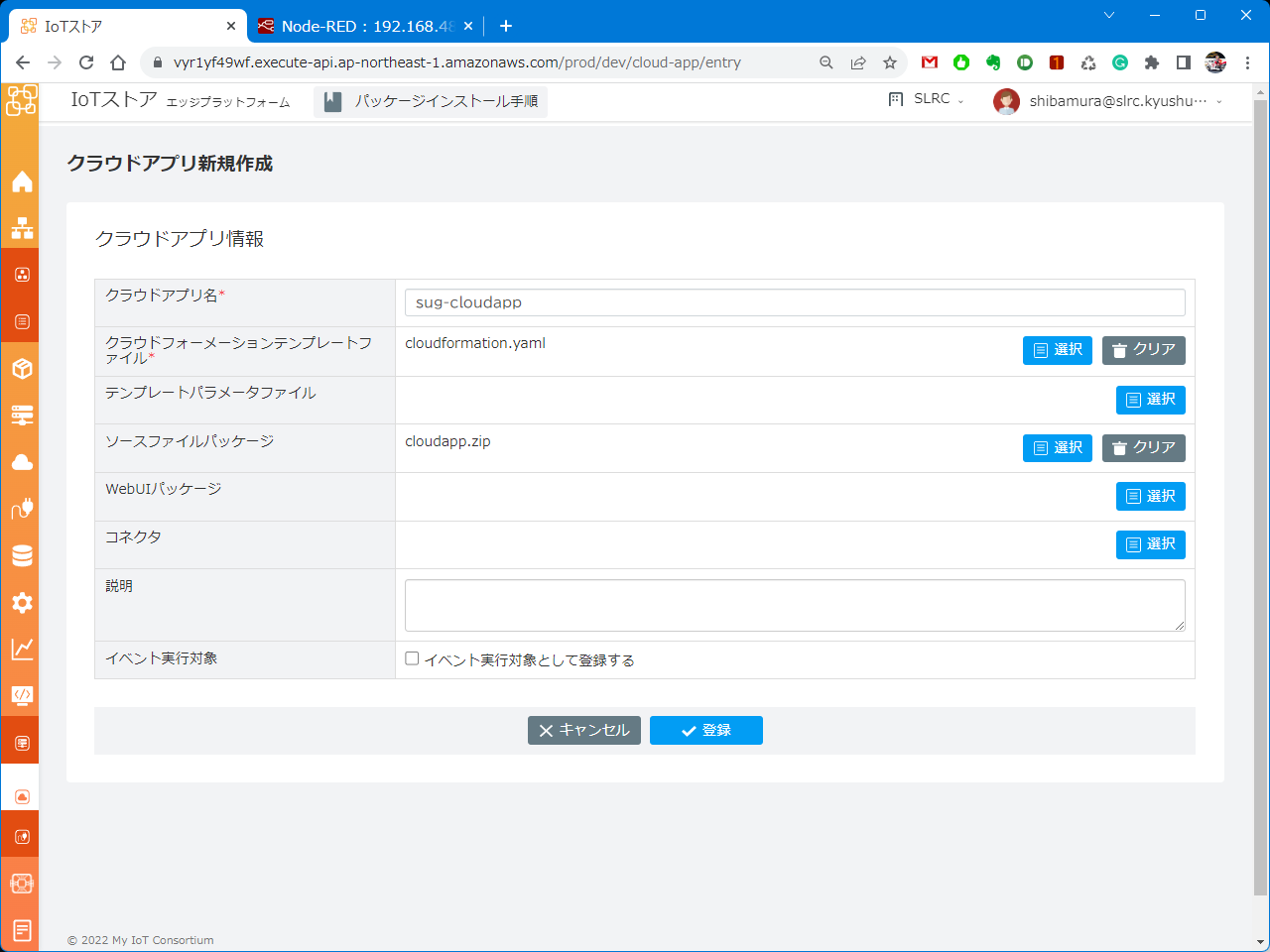6. クラウドアプリ開発
6.1. クラウドで実行するプログラムをPython言語で入力
クラウドアプリは、Python(プログラミング言語)によって動作します。 テキストエディタを利用して、次の二つのファイルを作成します。
クラウドアプリ(ファイル名:~.py)
クラウドコンピュータで実行されるプログラムです。 My-IoTが持つ機能を活用するためのAPIが用意されており、本アプリケーションから呼び出して利用します。
クラウドフォーメーション(ファイル名:~.yaml)
クラウドアプリをクラウドコンピュータにインストールするために必要な設定ファイルです。 YAML(ヤムル)と呼ぶデータ形式で記述します。
これらのファイル記述に精通するには慣れが必要です。 本初級編では、事前に用意したファイルを使い、まずは記述方法や使い方に慣れていきます。
「3. セットアップ」でダウンロードしたクラウドアプリ(cloudapp.py)を以下に示します。
import json
import boto3
import os
from datetime import datetime
from dateutil import tz
MQTT_API_NAME = (os.environ.get("MQTT_LAMBDA"))
ES_ACCESS_LAMBDA = (os.environ.get('ES_ACCESS_LAMBDA'))
TENANT_ID = (os.environ.get('TENANT_ID'))
def make_response(code, body):
response = {
'statusCode': code,
"headers": {"Content-Type": "application/json", "Access-Control-Allow-Origin": "*"},
'body': json.dumps(body),
"isBase64Encoded": False
}
return response
def dictHasKey(dictionary, key):
return isinstance(dictionary, dict) and key in dictionary
def get_param_from_event(event, paramName):
if dictHasKey(event, 'queryStringParameters'):
if dictHasKey(event['queryStringParameters'], paramName):
return event['queryStringParameters'][paramName]
return ''
def make_index_name(event):
JST = tz.gettz('Asia/Tokyo')
date = datetime.now(JST).strftime('%Y.%m.%d')
# インデックス名(テナントID_YYYY.MM.DD)を生成
index_name = '{}_{}'.format(TENANT_ID, date)
return index_name
def make_query(event):
query = {
'query': {
'bool': {
'should': []
}
},
'sort': [{'timestamp': 'desc'}],
}
# クエリにコネクタIDを設定
connector_query = {
'match': {
'connectorID': get_param_from_event(event, 'connectorId')
}
}
query['query']['bool']['should'].append(connector_query)
# クエリにページネーション用のページサイズとオフセットを設定
# 最新のデータを1件取得
query['from'] = 0
query['size'] = 1
# 生成したクエリを返す
return query
def lambda_handler(event, context):
# 入力チェック
index_name = make_index_name(event)
# クエリ
query = make_query(event)
# ペイロード
payload = {
'method': 'Get',
'index': index_name,
'query': query
}
# ESにアクセス
res = boto3.client('lambda').invoke(
FunctionName=ES_ACCESS_LAMBDA,
InvocationType='RequestResponse',
Payload=json.dumps(payload)
)
# レスポンス
response = json.loads(res['Payload'].read())
# 最新の環境データを取得
env = response["body"]["result"]["hits"]["hits"][0]["_source"]
temp = env["temp"]
humd = env["humd"]
# 不快指数を計算
# https://ja.wikipedia.org/wiki/%E4%B8%8D%E5%BF%AB%E6%8C%87%E6%95%B0
thi = ...
res_thi = {"thi": thi}
edgeID = get_param_from_event(event, 'edgeId')
payload = {
'tenantId': TENANT_ID,
'edgeId': edgeID,
'payload': res_thi,
'qos': 1
}
# My-IoT edgeにメッセージ送信
res = boto3.client('lambda').invoke(
FunctionName=MQTT_API_NAME,
InvocationType='RequestResponse',
Payload=json.dumps(payload)
)
# API URL呼出に対する返値
result = {
'error': 0,
'message': 'Sent a message to edge.',
'data': res_thi
}
return make_response(response['statusCode'], result)
# EOF
このプログラムでは、大きく以下の順序で実行されます。
lambda_handler()から実行を開始。
My-IoTデータストアを検索する際に必要なコネクタID(引数)をチェック
温度と湿度の最新データをMy-IoTデータストアから取得
不快指数を計算
エッジID(引数)を持つエッジに不快指数を送信
上記の4.は、Pythonプログラムの下方にある
thi = ...
の部分で計算します。 プログラムの温度や湿度を表す変数を調べ、 「2.2. システムの動作」で示した 不快指数の計算式を完成してください。
6.2. PythonファイルをZIP形式で圧縮
クラウドアプリをクラウドで実行させるには、My-IoTストアに登録する必要があります。 その際、登録はZIP形式のファイルで行います。 そこで、作成したPythonファイルをZIP形式で圧縮します。
クラウドアプリの圧縮(コマンドプロンプトでの例)
C:\myiot>zip cloudapp.zip cloudapp.py
adding: cloudapp.py (172 bytes security) (deflated 55%)
注意
zipコマンドが無い場合は、別途圧縮・展開ソフトウェアをインストールしてください。 Windowsの場合はExplorerを使ってZIP/UNZIPできます。
6.3. クラウドフォーメーションファイルをYAML形式で入力
クラウドアプリケーションをクラウドコンピュータにインストールするために必要な設定ファイルです。 クラウドアプリを実行する際のクラウドの仕様や各種APIの設定、アクセス権限の設定などを行います。 初級編では記述内容の説明を省略します。
AWSTemplateFormatVersion: "2010-09-09"
Description: An AWS function.
Resources:
###################################################################
# Lambda Function
myiotlm:
Type: "AWS::Lambda::Function"
Properties:
Description: ""
# file: cloudapp.py
Handler: cloudapp.lambda_handler
# DO NOT EDIT THIS 1 LINE
Role: "arn:aws:iam::946501391975:role/sip-sample-lambda-role"
Runtime: python3.7
MemorySize: 128
Timeout: 30
FunctionName: "myiot-lm"
Environment:
Variables:
# DO NOT EDIT THIS 1 LINE
ES_ACCESS_LAMBDA: myiot-rel-es-access-lambda
MQTT_LAMBDA: myiot-rel-publish-mqtt-lambda
SUBSCRIPTION: 'ex/{}/alert'
###################################################################
# ApiGateway
RestAPI:
Type: AWS::ApiGateway::RestApi
Properties:
Description: "myiot RestApi"
Name: "myiot-apigw"
RestAPIDeployment:
Type: AWS::ApiGateway::Deployment
Properties:
Description: ""
RestApiId:
Ref: RestAPI
DependsOn:
- RestAPIMethod
- RestAPIResource
RestAPIStage:
Type: AWS::ApiGateway::Stage
Properties:
RestApiId:
Ref: RestAPI
DeploymentId:
Ref: RestAPIDeployment
StageName: "myiot-stage"
RestAPIResource:
Type: AWS::ApiGateway::Resource
Properties:
PathPart: "{proxy+}"
ParentId:
Fn::GetAtt: RestAPI.RootResourceId
RestApiId:
Ref: RestAPI
RestAPIMethod:
Type: AWS::ApiGateway::Method
Properties:
HttpMethod: ANY
AuthorizationType: NONE
RequestParameters:
"method.request.path.proxy": true
Integration:
CacheKeyParameters:
- "method.request.path.proxy"
CacheNamespace:
Ref: RestAPIResource
IntegrationHttpMethod: POST
Type: AWS_PROXY
Uri:
Fn::Sub: "arn:aws:apigateway:${AWS::Region}:lambda:path/2015-03-31/functions/${myiotlm.Arn}/invocations"
ResourceId:
Ref: RestAPIResource
RestApiId:
Ref: RestAPI
###################################################################
# LambdaPermission
LambdaPermission:
Type: "AWS::Lambda::Permission"
Properties:
Action: "lambda:InvokeFunction"
Principal: "apigateway.amazonaws.com"
FunctionName: !GetAtt myiotlm.Arn
#EOF
6.4. クラウドアプリ登録
クラウドアプリ(ZIP形式)とクラウドフォーメーションファイルをMy-IoTストアに登録します。
WebブラウザからMy-IoTストアにアクセスし、左サイドバーから
開発⇒クラウドの順にクリックします。「クラウドアプリ一覧」の右上
新規作成をクリックします。「クラウドアプリ情報」内に各種設定を入力します。
「クラウドアプリ名」: 任意の名称を入力(例:sug-cloudapp)。
「クラウドフォーメーションファイル」:
選択をクリックし、cloudformation.yamlを選択。「ソースファイルパッケージ」:
選択をクリックし、cloudapp.zipを選択。

登録をクリックしてクラウドアプリをMy-IoTストアに登録(アップロード)します。
以上で、クラウドアプリ開発は終了です。
エッジアプリ開発のポイント
クラウドアプリを記述(Python)
クラウドアプリファイルのZIP化
クラウドフォーメーションファイルを記述
クラウドアプリをMy-IoTストアに2.と3.を登録